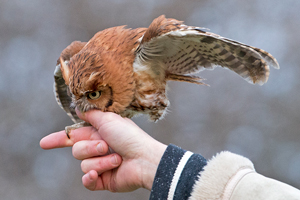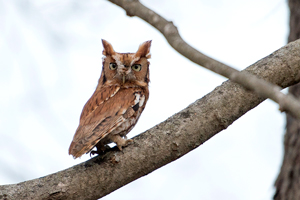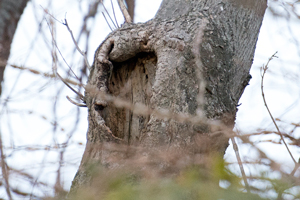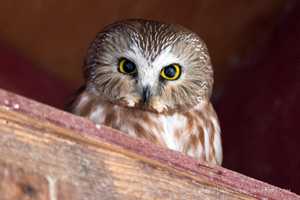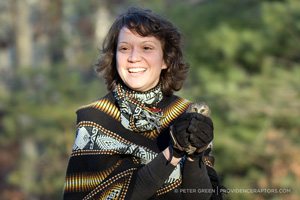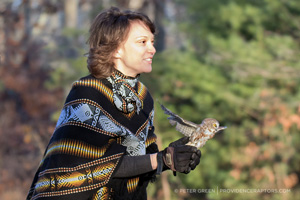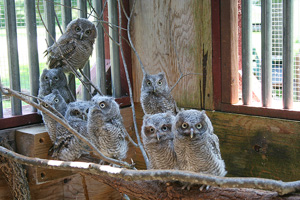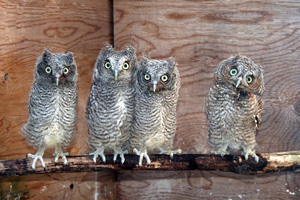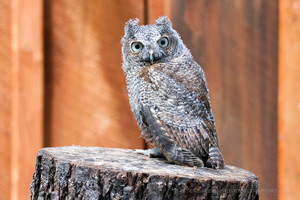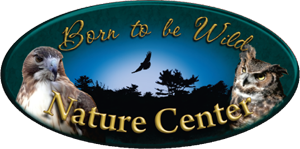
| Born to Be Wild Nature Center · Wildlife Rehabilitation in Rhode Island | btbwnc@gmail.com |
Rescue. Rehabilitate. Release.
There are some of our favorite releases...
There are some of our favorite releases...
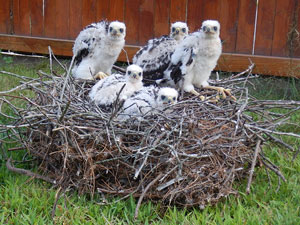
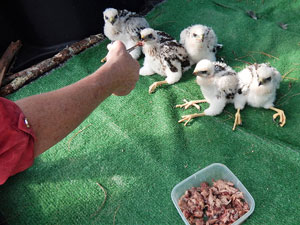
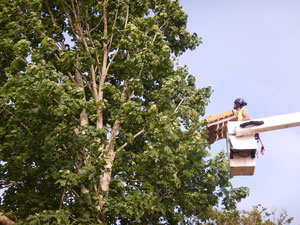
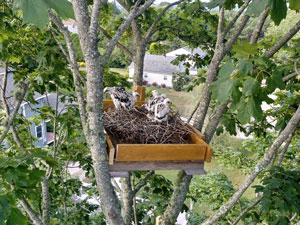
|
Quintuplets The call came in around 6 pm on Sun. July 1, 2018. It was a volunteer from the Wildlife Clinic, she was driving to Galilee to pick up a nest full of young hawks whose tree had been cut down, with them in it. Her question was "would we take them?" Our response was "of course, we'll meet you in a half hour". Arriving back at BTBW Nature Center, it was just after 7 pm. and there were five hungry mouths to feed. The young Broad-winged Hawks had had nothing to eat since morning. I began cutting up whole dead mice, while John got the nestlings settled into their new accommodations. Feeding time went quickly, as the five nestlings (estimated to be 2 weeks old) each gobbled down 5 mice. It would be a repeat the next morning, another 25 mice devoured!! We knew that the best thing for these youngsters would be reuniting them with their parents. This meant a flurry of phone calls that morning to coordinate with the tree service company, who had been responsible for the displacement of these nestlings. They sent an arborist to meet us later that afternoon with a large bucket truck capable of reaching heights greater than 60 ft. In the meantime, John constructed a wooden platform which would be installed in the new tree, in order to support the original nest & its' growing offspring. I took the nestlings to see Dr. Bird, one of our local wildlife Vets, just to make sure none of the babies had been injured in the fall. All five were given a clean bill of health. Zack, the arborist, arrived to the original location first and chose a large Maple tree in the same yard the hawks were found in. Working 50 feet in the air, Zack expertly installed the platform and then the nest. On the ground, I was feeding them one last meal so they wouldn't be hungry for a while. All there was left to do now was hoist them up (in a canvas shopping bag) to their new and improved nest and let their parents resume their duties. About 20 mins. after everyone left, neighbors called to tell us that mother hawk had flown to the nest with a mouse! Another successful re-nesting! |
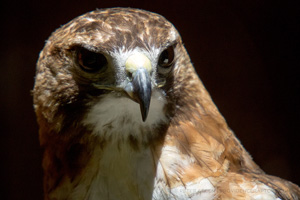
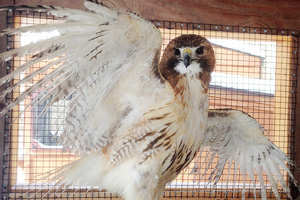
|
Phoenix, the Red-Tailed Hawk A truly remarkable Red Tailed Hawk came to us, through the Wildlife Clinic, after being badly burned by a methane flare at our central landfill. These flares are necessary to vent the gases from decomposing garbage and they flare off intermittently when the methane gases builds up. Unfortunately, the way they are designed, birds can perch on the pipes (and are killed when it ignites) or fly over them (as in Phoenix's case). It's a national problem with flare related bird deaths documented in at least 14 states. While he recovered at BTBW and started the long process of molting (growing) new feathers, Phoenix became the poster child for this problem. His story (and picture) was carried in several newspapers, magazines and featured in ecoRI.org. Local TV stations ABC6 and WJAR both covered Phoenix. This got the attention of officials at the landfill and they worked for several months to make the flares safer for all birds. They did this by removing any perching opportunities near the flares (poles, trees, sheds), they installed anti-perching devices on things they couldn't move like utility poles, buildings etc. and finally, they fitted the flares with steel spiked crowns that can withstand the extreme heat but prevent birds from perching there. One hawk CAN make a difference! We knew Phoenix must have a mate because he was an older bird (as well as charming and regal) and those are almost always pair bonded. So after he completed his molt and regained his endurance, we took him back to the landfill in Johnston, R.I. On a sunny September morning, with two friends and two officials there, we watched happily as he flew up in to a tree. On the way out, a female Red Tail was spotted. Phoenix sure had a lot of explaining to do! |
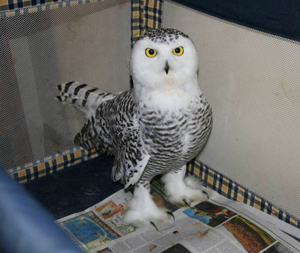
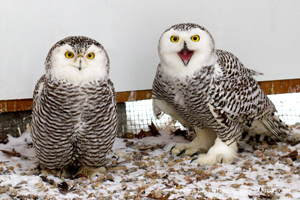
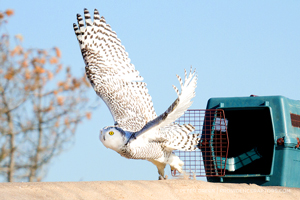
|
Snowy Owls On an recent epic migration from the arctic tundra, this female juvenile Snowy flew into a wire at the Quonset airport in N. Kingstown, RI. She was carefully transported to the wildlife clinic where x-rays confirmed a double fracture of her wing. She was transported to BTBW for rehabilitation. For the first two weeks at BTBW, she was kept in a soft sided playpen to restrict any movement of the broken wing. Standing 2.5 ft tall and weighing over 5 lbs, the Snowy Owl is an impressive sight. Soon, she was moved outdoors to a flight cage where she could begin exercising and strengthening the newly healed wing. It was at this time that a second Snowy Owl arrived at BTBW. It was another juvenile female who had been struck by a car in Providence, R.I. She had received head trauma but was well enough to be put outside with the first owl. They got along beautifully. Within a month, both owls were ready to be released. This was such a rare and unusual circumstance in our region, that CBS Nightly News drove down from NYC to film the release of our owl for a story they were covering on Snowy Owls. It aired on both the nightly and morning addition of the CBS national news. Click here to see CBS video coverage of the Snowy Owl invasion. As if this weren't exciting enough, we returned home in time to receive our third and final Snowy Owl. This time it was a young male who had signs of lead poisoning. He was weak and lethargic but once on a proper diet, his condition quickly improved. In the arctic, Snowys feed almost exclusively on lemmings. But during their southerly migration, these powerful owls hunt ducks and other birds along the shoreline. It was presumed that this male had fed on a duck killed by a hunter using lead shotgun pellets. At BTBW, we fed the Snowy Owls a healthy diet of quail. Within a few short weeks, we were able to release this owl so that he could continue his journey back to the Arctic. |
| Born to Be Wild Nature Center · Wildlife Rehabilitation in Rhode Island | btbwnc@gmail.com |
| Website by Double Agent Design |
